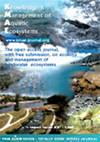在一条被入侵的日本河流中,普通的河狸捕食联合贻贝和陆生植物
IF 1.7
3区 环境科学与生态学
Q3 FISHERIES
引用次数: 6
摘要
河狸是一种半水生食草啮齿动物,在日本被怀疑捕食淡水淡水鱼贻贝。以双壳类和陆生植物为目标的粪便DNA元条形码研究了日本中部木索河的外来河狸鼠的饮食。在四个漫滩水体中按季节收集32份粪便样本。在其中一个水体中,研究人员对活贻贝和死贻贝进行了调查,以研究河狸捕食贻贝对贻贝种群结构的可能影响。在两个水体中证实了河狸鼠捕食联合贻贝的常见行为。海底调查显示,中、大型贻贝容易被河狸鼠吃掉;可能导致种群结构中很少有大型个体。此外,还发现了陆生植物的季节性饮食选择:有两种多年生植物是全年食用的,而一些多年生植物是季节性食用的。夏季作为主要食物的陆生植物种类/类群数量高于冬季,这与夏季对一年生植物的高消耗有关。未来的研究需要检查河狸鼠包括其他动物和植物的详尽饮食,以及它对入侵地区淡水生态系统的影响。本文章由计算机程序翻译,如有差异,请以英文原文为准。
Common coypu predation on unionid mussels and terrestrial plants in an invaded Japanese river
The coypu (Myocastor coypus) is a semi-aquatic herbivorous rodent that has been suspected to prey on freshwater unionid mussels in Japan. Fecal DNA metabarcoding that targeted bivalves and terrestrial plants was performed to examine the diet of exotic coypu in the Kiso River, central Japan. Thirty-two fecal samples from four floodplain waterbodies were collected seasonally. In one of the waterbodies, live and dead mussels were investigated to examine the possible effects of coypu predation on mussel population structures. Common coypu predation on unionid mussels was confirmed in two waterbodies. Midden surveys showed that medium- to large-sized mussels tended to be consumed by coypu; possibly resulting in population structures with few large-sized individuals. Seasonal diet selection of terrestrial plants was also detected: two perennial plants were consumed throughout the year, whereas some perennial plants were consumed seasonally. The number of terrestrial plant species/taxa as primary food was higher in summer than in winter, which was attributed to the high consumption of annual plants in the summer. Future studies need to examine the exhaustive diet of coypu including other animals and plants, as well as its effects on freshwater ecosystems in invaded regions.
求助全文
通过发布文献求助,成功后即可免费获取论文全文。
去求助
来源期刊

Knowledge and Management of Aquatic Ecosystems
环境科学-海洋与淡水生物学
CiteScore
3.70
自引率
5.60%
发文量
22
审稿时长
>12 weeks
期刊介绍:
Knowledge and Management of Aquatic Ecosystems (KMAE-Bulletin Français de la Pêche et de la Pisciculture since 1928) serves as a foundation for scientific advice across the broad spectrum of management and conservation issues related to freshwater ecosystems.
The journal publishes articles, short communications, reviews, comments and replies that contribute to a scientific understanding of freshwater ecosystems and the impact of human activities upon these systems. Its scope includes economic, social, and public administration studies, in so far as they are directly concerned with the management of freshwater ecosystems (e.g. European Water Framework Directive, USA Clean Water Act, Canadian Water Quality Guidelines, …) and prove of general interest to freshwater specialists. Papers on insular freshwater ecosystems and on transitional waters are welcome. KMAE is not a preferred journal for taxonomical, physiological, biological, toxicological studies, unless a clear link to ecological aspects can be established. Articles with a very descriptive content can be accepted if they are part of a broader ecological context.
 求助内容:
求助内容: 应助结果提醒方式:
应助结果提醒方式:


